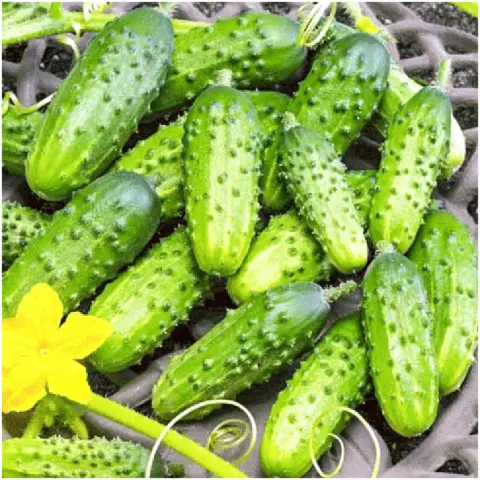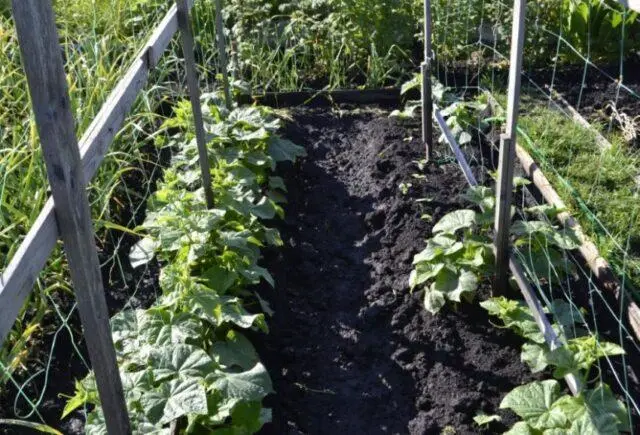Contents
Cucumber Hummingbird is a high-yielding variety of the gherkin type. Resistant to a number of diseases, unpretentious, so the culture can be grown in most regions. Fruits appear until the beginning of autumn, fruiting ends with the onset of the first frost.
Origin of the variety
Cucumber Hummingbird is a hybrid of the first generation (F1), bred on the basis of the Manul breeding and seed company. A group of researchers took part in the development of the variety: Borisov A.V., Vostrikova O.R., Skachkov V.A., Orekhova E.A. and others. Included in the register of breeding achievements in 2010.
Hummingbird cucumber is approved for cultivation in most regions:
- middle lane;
- the Volga region;
- Northwest;
- Chernozem region;
- southern regions;
- The Urals;
- Western and Eastern Siberia;
- Far East.
Recommended for growing in film shelters (without heating). In the south, the culture can be cultivated in open ground.
Description of the Hummingbird cucumber variety
In the description of the Hummingbird cucumber variety, the following characteristics are given:
- indeterminate (growing throughout the season);
- flowering type: predominantly female;
- weakly branched (few shoots);
- undersized.
The stem of the plant reaches a height of 25-30 cm, spreads along the ground, winds. The bush is characterized by kidney weaving, gives a lot of tendrils, which allows it to be well attached to any support. The green mass grows quite quickly, the lateral sinuses of Hummingbird cucumbers are small.
The leaves are deep green, heart-shaped, have five lobes. In the axil of each leaf, 4-5 ovaries appear, less often two or eight. The flowers are small, typical yellow color. Flowering goes amicably, Hummingbird cucumbers do not need pollinators. This makes it possible to grow them in closed greenhouses.
Fruits of gherkin type, small size (length 5-8 cm, diameter not more than 3,5 cm). The color is saturated green, the average weight is 60-80 g. The pulp is juicy, crispy, the taste is good. Greens are short, fusiform, tuberculate, with white pubescence. Cucumbers are not prone to overgrowing, so the commodity yield is consistently high. Fruits are mainly used for harvesting, less often fresh.

Hummingbird cucumbers are suitable for pickling and pickling
Characteristics of Hummingbird cucumbers
The variety is quite unpretentious. Hummingbird cucumbers grow well in different types of soil. Under the right growing conditions, they give a consistently high yield. The culture is sensitive to frost, therefore, in most regions, cultivation is allowed only in closed ground. Drought also has a bad effect on productivity – additional watering is required in the heat.
Cucumber yield Hummingbird
The marketable yield of Hummingbird cucumbers, subject to the rules of agricultural technology, reaches 11-13 kg per square meter. In terms of maturation, the variety belongs to the category of early (early ripe). The first harvest can be harvested 40 days after planting the seeds (technical ripeness), optimally – after 48-50 days.
The fruiting period is long, until the onset of frost. Therefore, the crop can be harvested even in late summer and early autumn (August, September). The fruits appear together, which makes them easier to collect.
Disease and pest resistance
Hummingbird F1 cucumbers are resistant to a number of diseases: cladosporiosis, cucumber mosaic virus, powdery mildew.
Less resistant to downy mildew (peronosporosis). May suffer from such fungal and bacterial infections:
- white and gray rot;
- anthracnose;
- bacteriosis.
It is not excluded the defeat of aphids, nematodes, spider mites, slugs and other pests. To prevent crop loss, Hummingbird cucumber plantings should be periodically inspected.
Advantages and disadvantages
The grade differs in high productivity and good taste of fruits. These are classic regular-shaped gherkins that can be grown in a greenhouse and even on a windowsill. A lot of fruits are formed, so they are used both for personal consumption and for sale.

Hummingbird cucumbers are approximately the same size (up to 8 cm long)
Pros:
- very high productivity;
- good taste;
- early ripening (only 1,5 months);
- attractive presentation;
- long fruiting;
- can be grown in any region;
- fruits do not outgrow;
- resistance to a number of diseases;
- keeping quality and transportability.
Cons:
- seeds have to be constantly bought;
- after pickling, cucumbers may become soft;
- frost resistance is low;
- germination is weak;
- no immunity to certain diseases and pests.
Planting Hummingbird Cucumbers
The timing of sowing seeds of Hummingbird cucumbers depends on the method of cultivation and the climate in the region:
- when growing seedlings, seeds are planted from early to mid-April;
- seedlings are transferred to open ground at the age of 25 days from mid to late May;
- if you plant seeds immediately in the garden, you can do this no earlier than mid-May (in the south in the last days of April, in the Urals, in Siberia – towards the end of May).
When planting seeds in a greenhouse, as well as when transferring seedlings of seedlings under a film, the dates are shifted a week earlier. In this case, you need to take into account the weather forecast – the seeds can be planted a little later to wait out the period of return frosts.
Sowing in open ground
For outdoor cultivation, choose an open area, protected from strong winds. The place is cleared in advance. The earth is dug up and fertilized with humus, compost (in a bucket of 2 m2). If there is a lot of clay in the soil, you need to add sawdust or sand (1 kg for the same area).
Hummingbird cucumber seeds on the eve of planting also need to be prepared:
- hold for half an hour in a 2% solution of potassium permanganate;
- hold for 2 hours in a fungicide (“Fitosporin”, “Baksis”);
- the day before planting, withstand 7-8 hours in a growth stimulator (for example, Agat, Baikal, Sodium Humate).
The surface of the beds is leveled, furrows are marked with an interval of 40 cm. Holes 1-2 cm deep are formed in parallel or in a checkerboard pattern. Cucumber seeds are planted at a distance of 5-7 cm, buried and watered. After the appearance of three leaves, the seedlings are thinned out so that there are no more than four plants per square meter.

Hummingbird cucumber seedlings are transplanted into the ground no earlier than mid-May
Growing seedlings
Planting material for Hummingbird cucumbers is prepared in the same way as described above. The soil should be disinfected with boiling water or a solution of potassium permanganate. You can also keep it in the freezer for a few days. For growing suitable universal soil for seedlings. The mixture can be prepared in advance independently, for example, from garden soil mixed with humus, black peat and sand in a ratio of 2: 1: 1: 1.
Instructions for growing seedlings of Hummingbird cucumbers are standard:
- Plant the seeds in boxes or cassettes to a depth of 2 cm, maintaining an interval of 5 cm.
- Pour from a spray bottle.
- Cover with foil and put in a warm place (23-26 degrees).
- After the emergence of shoots, the film is removed.
- At the same moment, you can feed with a complex composition, for example, “Kemira”, “Mortar”, “Ideal”.
- Continue to maintain the temperature at the same level.
- Water periodically. A month after planting, they are transplanted into a greenhouse or into an open garden.
Hummingbird Cucumber Care
Hummingbird cucumbers require some attention. They give a good harvest only if the rules of agricultural technology are observed:
- Regular watering (twice a week), but without waterlogging. The topsoil should remain slightly moist.
- The first top dressing for cucumbers is given two weeks after planting, then twice more every 2-3 weeks. The best option is the alternation of a complex mineral composition with organic matter (mullein, litter, humates).
- Hummingbird cucumber bushes curl well, give a lot of antennae, so a garter is required. To do this, install a trellis and pull the rope, and the height of the structure is small – up to 50 cm.
- Loosening and weeding is carried out regularly.
- Planting Hummingbird cucumbers is desirable to mulch with straw, mowed grass, sawdust or needles.

When growing Hummingbird cucumbers, garter supports must be installed
Conclusion
Hummingbird cucumber is best grown in greenhouses, on fertile, light soils. Then he will give consistently high yields of delicious gherkins. Their care is standard, so even novice gardeners can grow cucumbers.









